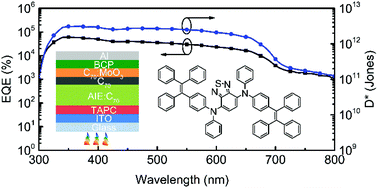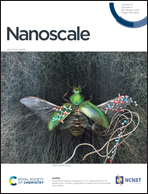Structure design and performance of photomultiplication-type organic photodetectors based on an aggregation-induced emission material†
Abstract
Aggregation-induced emission (AIE) materials have shown attractive prospects in the fields of biological probes, chemical sensing, optoelectronic systems and stimuli responses. Here, we have successfully fabricated photomultiplication-type organic photodetectors based on an AIE material by designing a device structure. The high photoconductive gain was attributed to the interfacial trap-assisted hole-tunneling injection caused by MoO3 as the trap for electrons. The fabricated AIE-based photomultiplication-type organic photodetectors exhibited the figures of merits of high external quantum efficiency in excess of 60 000%, responsivity of 172 A W−1, detectivity of 3.08 × 1012 Jones, and photoresponse with a rise time of 1.69 ms. Moreover, the devices also showed good stability with a half-life of 700 hours at continuous testing under ambient conditions, which makes them one of the most stable OPDs reported so far. The results demonstrate that AIE molecules are an excellent kind of photodetective material.



 Please wait while we load your content...
Please wait while we load your content...